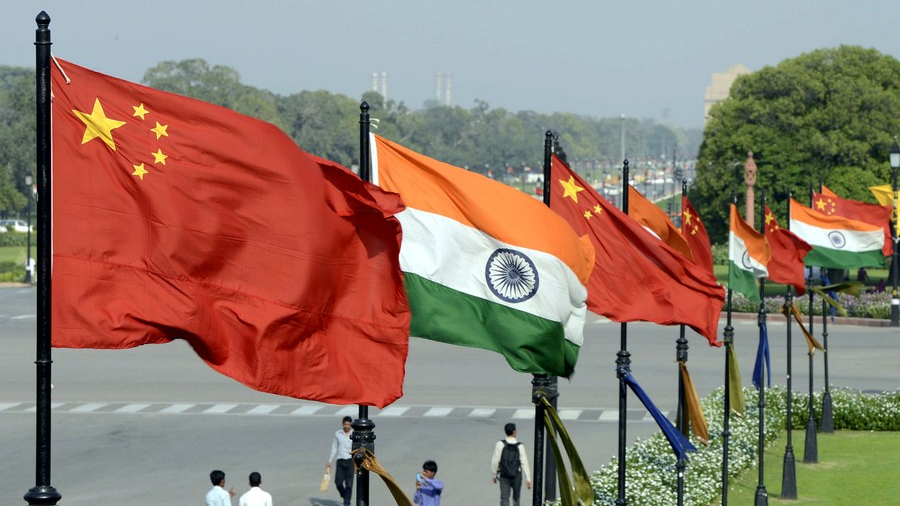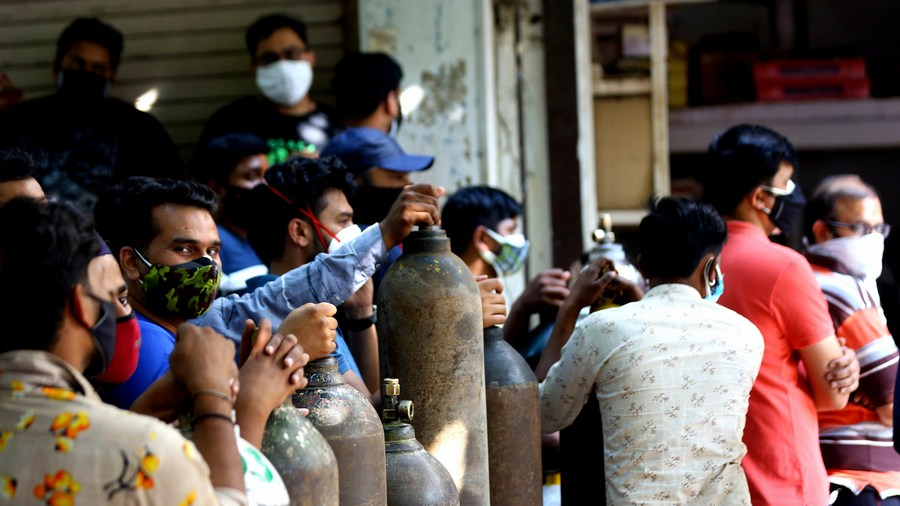
Indian and Chinese national flags flutter side by side on the lamp posts at the Raisina Hills in New Delhi, September 16, 2014. /Xinhua
Indian and Chinese national flags flutter side by side on the lamp posts at the Raisina Hills in New Delhi, September 16, 2014. /Xinhua
Editor's note: Rabi Sankar Bosu is an Indian contributor to Chinese media outlets. He writes about Chinese politics, social and cultural issues, and China-India relations with a special interest in the Belt and Road Initiative. The article reflects the author's views, and not necessarily those of CGTN.
India's Minister of External Affairs Subrahmanyam Jaishankar and Chinese State Councilor and Foreign Minister Wang Yi had a crucial meeting on the sidelines of Shanghai Cooperation Organization (SCO) Foreign Ministers Meeting on July 14 in Dushanbe, Tajikistan to discuss how to take forward the relations between the two neighboring countries, India and China, leaving behind the protracted military standoffs in the Galwan Valley along the Line of Actual Control (LAC) in Ladakh region since May last year. Despite points of difference on the India-China standoff, the one-hour meeting between the two ministers holds special significance for more than one reason.
It is immensely gratifying to see that during the meeting, both Wang and Jaishankar discussed how the two largest developing and emerging economies can open new pathways of cooperation, blending Indian and Chinese dreams while intensifying their efforts to achieve a fair, reasonable and acceptable solution to the long-pending boundary dispute at the earliest. "Sino-Indian interaction should still be cooperation-led, mutually beneficial and complementary, with healthy competition and avoidance of confrontation," Wang said.
The second face-to-face meeting of the two foreign ministers took place against a favorable backdrop of improving relationship between the two Asian giants. The scenario of the dragon and the elephant dancing together has acquired a fresh resonance after the February 11, 2021, LAC disengagement agreement as part of the five-point agreement reached between the two foreign ministers in Moscow on the sidelines of the SCO conclave on September 10, 2020.
It must be noted here that since the February disengagement agreement, the India-China border area has generally remained peaceful and stable. The trust has built up between the Indian and Chinese frontline troops "with no transgressions happening with no violations of this disengagement" as stated by Indian Army Chief General M M Naravane on May 19. He also expressed hope that both sides would be able to make forward movement in resolving issues in other border areas.
On the other hand, the 22nd round of talks of the Working Mechanism for Consultation and Coordination on India-China Border Affairs on June 25, 2021 clearly indicated the possibility of intense exchanges between the two sides through the diplomatic and military mechanisms on the situation along the LAC.

People wait in line to refill empty medical oxygen cylinders for COVID-19 patients in front of a shop in New Delhi, India, April 26, 2021. /Xinhua
People wait in line to refill empty medical oxygen cylinders for COVID-19 patients in front of a shop in New Delhi, India, April 26, 2021. /Xinhua
However, despite multiple rounds of military and diplomatic talks between the two sides, the two Himalayan neighbors have not yet reached a complete agreement on disengagement of troops from all conflict points including Hot Springs, Gogra and Depsang in the mountainous region. Both Indian and Chinese troops have been standing eyeball to eyeball in a high state of combat readiness in various mountainous locations along the LAC in a hostile environment for nearly 14 months.
As such, both ministers agreed to hold the 12th round of Senior Commanders Meeting at an early date to achieve the objective of complete disengagement in remaining friction points. It has been revealed that the Chinese foreign minister urged India to "refrain from any unilateral actions in sensitive disputed areas, and prevent the situation being repeated due to misperception and miscalculation."
While conveying India's position on the border tension with China on the LAC, it's really encouraging to hear that Indian minister assured his Chinese counterpart that "India is willing to work together with China to push bilateral relations out of the trough."
It should be noted here that right after the deadly clash in the Galwan Valley on the night of June 15, 2020, the Sino-India relationship has turned a new modus vivendi with the LAC militarizing by both sides. Amid an India-China blame game over the LAC standoff, "China and India have sent tens of thousands of soldiers and advanced military equipment to their disputed border, as troop deployments in the region reach the highest level in decades," according to a report of the Wall Street Journal on July 2.
On the other hand, India has shifted at least 50,000 additional troops to its "disputed" border with China under a strategy known as "offensive defense," according to a Bloomberg report. But such type of military upgrades of both sides is certainly not conducive to easing India-China border tensions, rather it could only stir up more trouble in bilateral ties.
Indian political leadership at center must realize that in the era of globalization, India's sedulous courtship of the U.S., the resuscitation of the Quad Security Dialogue, banning some Chinese apps and cancellation of some public contracts with Chinese firms do not promote healthy and stable development of India-China relations, rather it will derail India's dream of being a global power of a "$5 trillion economy" by 2024 by excluding "Made in China." Despite calls to boycott Chinese products and imposing restrictions on Chinese investment, China surpassed the United States in 2020 to become India's largest trading partner.
During the meeting, Wang reiterated that "China and India are each other's partners, not rivals or enemies." After the outbreak of the devastating second wave of COVID-19 pandemic in India, China was one of the first countries to offer support to India to help fight against the pandemic, which is a perfect example of the "2,000 years of unbroken friendship" between the two neighboring countries. China exported more than 100,000 oxygen concentrators, 8,000 ventilators, 90,000 thermometers and over 100 million masks to India just during the first half of May, according to Chinese Ambassador to India Sun Weidong.
Although some frictions emerged from the thorny border issue occasionally, the canvas of the multi-hued bilateral relationship should be enhanced in all areas, especially in the fields of trade, economy and technology, and of course, people-to-people relations in order to make bilateral relations better, brighter and stronger.
Time has come for the two countries to bridge the gap in mutual understanding. Hopefully, the meeting between Wang Yi and S. Jaishankar has raised the bar for the Sino–India relationship.
(If you want to contribute and have specific expertise, please contact us at opinions@cgtn.com.)

